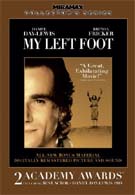Lately filmmakers have been fixated on stories about people who are overcome by extreme physical difficulty and cave to the pressure, seeking the easy yet dignified way out of an existence they didn’t ask for. Recent projects like Million Dollar Baby and Mar Adentro (The Sea Inside) tackle such situations with tragic finales. While the realities of those films are legitimate, there’s something much more satisfying and powerful about a story of someone who makes the best of a troubled existence and achieves astonishing things. It’s especially satisfying when the story is true. “There’s been some complications.” That was what the nurse told Mr. Brown to explain the birth of his son, Christy. Brain damage resulting in cerebral palsy would leave the boy unable to use any of his limbs save one, his left foot. The 1930’s weren’t exactly the pinnacle for medical understanding of cerebral palsy and most people affected by the condition were institutionalized and assumed mentally retarded. Christy’s father, a dedicated but harsh man, refused to have him put in a home but only his mother saw what no one else would. There was a perfectly intelligent person in Christy’s body, waiting to find a way out.
Originally released in 1989, My Left Foot tells the story of Christy Brown’s search for that way out. That escape would come when the boy one day took a piece of chalk from his sister with this left foot and began scrawling a single word on the floor of their humble Dublin home: ‘mother’. From that moment on an unexpected artistic and creative force would slowly be released into the world. Even before he had learned to speak clearly, Christy Brown had begun to draw and paint with his one functioning appendage. Eventually he would move on to become a successful author, writing several novels, books of poetry and his autobiography. He led the life of an Irishman not a cripple, struggling more often with the emotional challenges of an artist, brother and son than those of a handicapped man.
It’s completely refreshing to watch a film where the main character is severely incapacitated in the eyes of those around him, but whose perspective on life is not so limited. There’s no “woe is me, I’m crippled” or “I want to end my life because it’s not the hand I wanted to be dealt”. Brown pushes through each obstacle and sees his relationships, not as a dependence caused by his handicap, but as a co-existence he shares with those he loves and who love him. That’s not to say he never struggles with his condition, but his life story is not defined by it. Best of all, it’s simply a story, and a beautiful one at that. There are no political, religious or bleeding heart causes being pandered to and I felt free to walk away having enjoyed the beautiful and tragic moments, no strings attached.
Given the plot’s subtleties and even pace, it falls to the actors to make the story shine. They succeed in tremendous ways. Daniel Day-Lewis is astonishing as Christy Brown. Many actors have achieved award winning performances by playing characters with physical or mental difficulties, but Lewis exceeds them all. He pays attention to every detail and completely immerses himself in what is the most physically challenging role I’ve ever seen played.
Lewis, however, is only the tip of the iceberg. Hugh O’Connor, who plays the young Christy Brown, equals Lewis in his physical and emotional performance. Brenda Fricker has a tremendous task in playing loving mother, not just to Christy, but to twelve other children as well, not to mention understanding wife to a difficult husband. It’s no wonder Lewis and Fricker each walked away with an Oscar.
Despite being distributed in the United States by Miramax, the film is wholly home grown, written, produced and directed by folks from Dublin and starring predominantly UK actors. The pacing and storyline move to a gentler drum that we yanks are used to, quietly telling a story rather than building to a sensational, emotional climax. American audiences may not be so sympathetic with a character whose joys and victories, sorrows and failures come in bursts throughout the film instead of building to a tremendous finale. I would hate to hear that complaint from anyone though. Real life is rarely like the movies, so why shouldn’t movies sometimes be like real life? Miramax has a lot to be proud of, but its “Collectors Edition” DVD series isn’t on that list. My Left Foot is a wonderful film, and having it available on DVD is excellent unto itself, but the complete lack of accompanying material hardly warrants this package receiving any kind of special title.
The entirety of the bonus material can be viewed in less than twenty minutes. Don’t get me wrong, they’re an excellent, high quality twenty minutes, but there’s plenty more that could have been covered and its absence is embarrassing.
Your Daily Blend of Entertainment News
There are two very short featurettes, one about the movie and one about the man. Producer, writer and some of the cast lend their recollections about how the production progressed and share a little about what they came away with from the film. Conspicuously absent are Lewis and Fricker. In my book, any movie that earns an actor an Academy Award should include some input from that actor in a “Collector’s Edition” DVD release. I can’t imagine Lewis would have turned down the opportunity and I suspect Miramax probably just didn’t try hard enough.
Also missing in action is director Jim Sheridan. In fact, there is no commentary from anyone at all, a must-have for any kind of special release. At the very least they could have sat writer Shane Connaughton down and let him discuss his process. He seemed more than happy to turn up for the featurette.
As if the lack of sufficient material weren’t enough, Miramax further slaps its customers in the face by tacking on four reviews of the film from prestigious publications. I could already tell from the cover that the movie had been nominated for several Academy Awards and didn’t really need anything to further confirm its acclaim. I’d much rather have seen some excerpts from Brown’s book or nothing at all.
There is a very short collection of studio production shots that you can scroll through but it’s nothing to get excited about. In its favor the disc has some very lovely menu screens, something you don’t usually see in releases this minimal. Overall the package is disappointing and only serves to further my suspicion that Miramax is in the business of selling snake-oil collector’s editions. I’m not impressed.

